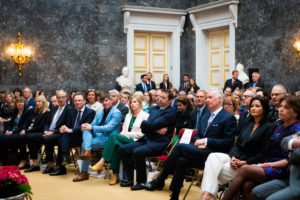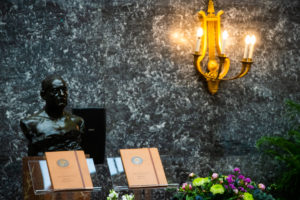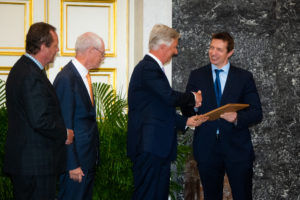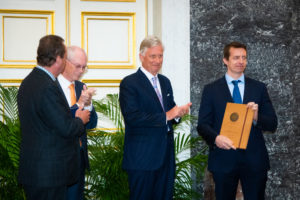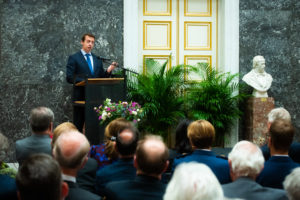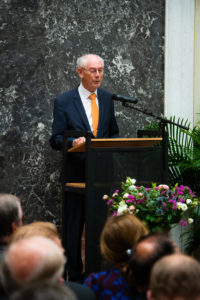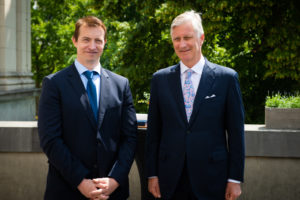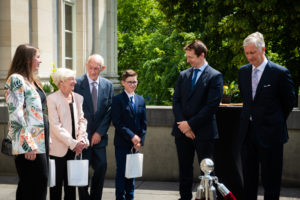2021 Report Michaël GILLON
Ceremony of the Francqui Prize by his Majesty The King on June 1, 2022
(by invitation only )
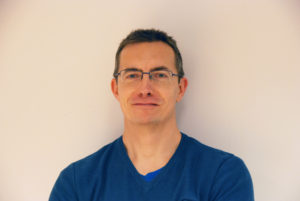
Background – Works – Report of the Jury
His background
Michaël Gillon was born in Liège in 1974 and grew up in Louveigné, a small village in the Liège region. From his earliest childhood, this son of a municipal worker and a secretary has always been attracted by the stars and fascinated by the possible existence of life elsewhere in the Universe.
He did his high school studies at the Athenaeum of Esneux (1st to 4th year), then at the one of Aywaille (5th and 6th year). As a dreamy teenager, he was seeking himself a lot. He ws interested in the sciences (biochemistry in particular) but was intimidated by university studies, presented to him as extremely difficult. Thus, at the end of his secondary studies at the age of 17, pushed by his taste for sports, he started a career in the Belgian army, in the infantry. After a few years as an infantryman in the Régiment des Chasseurs Ardennais de Marche-en-Famenne, he developed a nervous system disease (fibromyalgia) which made his work as a soldier less and less rewarding. Physically diminished, he then took refuge in reading, in particular numerous popular science books which developed in him an ever stronger passion for the study of life, the Universe, and their mysteries. Discharged from the army for medical reasons in 1998, he embarked then, at the age of 24, on a 1st year in biology at the University of Liege. This was a revelation. To his surprise, his grades were excellent, which reinforced his self-confidence and exacerbated his desire to learn and understand. He then combined, still in Liège, the study of biology with the one of physics (bachelors), then of biochemistry and astrophysics (masters).
In 2002, he started, still in Liège, a PhD in astrophysics focused on the CoRoT space mission. One of the scientific objectives of this mission was the detection and study of exoplanets, a young field then in full expansion (the first exoplanets were only detected in 1992) intimately linked to the question that has always fascinated Michaël Gillon: is there life elsewhere in the Universe?
After defending his thesis in March 2006, for which he obtained the highest distinction, he left for a post-doctoral stay at the Geneva observatory where he joined the group of Michel Mayor and Didier Queloz, pioneers in the field who were awarded the Nobel Prize in 2019 for their detection of the first exoplanet orbiting a star similar to the Sun
Back to the University of Liege in January 2009, first as a post-doctoral researcher, then as a FNRS Research Associate in 2010 and FNRS Senior Research Associate in 2018, Dr. Gillon continued his work on the detection of exoplanets and their physicochemical characterization. He was notably at the origin of the TRAPPIST project, based on a robotic telescope that he installed with colleagues from Liège at the European Southern Observatory of La Silla in Chile in 2010, and for which he leads the exoplanet program. He also designed and developed the SPECULOOS project aiming to detect potentially habitable exoplanets in transit around nearby low-mass stars. In 2020, he developed with his colleague Emmanuelle Javaux from Liège a new Research Unit at the University of Liège dedicated to astrobiology, a multidisciplinary field of research dedicated to the study of the origin, evolution, distribution, and future of life in the Universe.
During his career, Dr. Gillon has received numerous awards, including a prestigious Balzan Prize in 2017 and the NASA Exceptional Scientific Achievement Medal in 2018. He was also nominated as one of the 100 most influential people on the planet by Time magazine in 2017.
Michaël Gillon likes to share his passion for research with the general public, notably through conferences and his participation in television documentaries. He is also passionate about science fiction literature. He lives with his family in Anthisnes, a small village in the Liège region. His partner’s first name is Wendy, and he is the proud father of Amanda and Lucas.
* * *
His works
In 1995, a new era of modern astronomy began with the discovery of the first planet orbiting another Sun-like star. Since then, several thousand such « exoplanets » have been discovered, revealing an unexpected diversity of planetary systems on a galactic scale. We now know that most stars in the Milky Way – and by extension in the Universe – have their own set of planets, and that the architecture of our solar system is by no means the norm. Moreover, it is now established that planets of similar size and mass to the Earth are very common around stars other than the Sun, and that our Galaxy alone harbors tens of billions of potentially habitable worlds. In the near future, some giant telescopes should even be able to probe the atmospheric compositions of some of these planets, in order to look for chemical traces of biological origin.
Since his Ph.D at Liège from 2002 to 2006, Dr. Gillon has made several major contributions to this « exoplanet revolution », focusing his pioneering research on the subset of exoplanets that transit (i.e. eclipse) their parent stars, motivated by the detailed characterization (orbit, mass, radius, atmosphere, etc.) made possible by this particular geometrical configuration.
In 2007, only one year after completing his PhD thesis, he started a search for « transits » (i.e. the passing in front of their star) of low mass planets. This search led to the first measurements of the size and density of an exoplanet significantly smaller than Jupiter, GJ436b, which turned out to be of similar density to Neptune.
In 2008, he imagined and developed the project of a small robotic telescope optimized for the measurement of exoplanet transits. This project, which he named TRAPPIST, came to life in 2010 in Chile thanks to funding from the FNRS. Under the leadership of Dr. Gillon, its exoplanet program has contributed to the discovery of more than two hundred planets between 2010 and 2021.
In 2009, Michaël Gillon led the first robust measurement of the thermal emission of an exoplanet from the ground, using the European Very Large Telescope located in Chile. At the same time, he imagined a new project aiming at detecting potentially habitable exoplanets suitable for detailed atmospheric studies, or even for the detection of traces of life (biosignatures). In order to reach such an ambitious goal, the concept of the project (named SPECULOOS by Dr. Gillon) was to focus on stars neglected by other exoplanet searches, the « ultra-cool dwarf stars », stars much less massive and cooler than the Sun and of comparable size to Jupiter. While theoretical estimates at the time predicted a low frequency of Earth-like planets around these miniature stars, Michaël Gillon had the intuition of the opposite and thought that SPECULOOS could discover the first exoplanets suitable for the search for traces of life.
In 2010, Michaël Gillon initiated another project to search for exoplanet transits, this time with NASA’s Spitzer space telescope. In 2011, this study detected the transit of a « super-Earth » in orbit around the nearby star 55 Cancri, and revealed its rocky composition. By continuing their observations, he and his team could then detect the « light » of the planet (its thermal emission), a first for a planet of such a small size.
In 2011, Dr. Gillon decided to use TRAPPIST as a prototype for SPECULOOS, observing one after the other a sample of about 50 very close ultra-cold stars in order to demonstrate the possibility of detecting a potentially habitable Earth around these tinu stars (and thus convince various sponsors to fund SPECULOOS).
At the end of 2015, SPECULOOS was partially funded (notably by the European Research Council) and in full development, and its prototype on TRAPPIST was still in progress. Its observations revealed then the existence of three Earth-sized planets around a nearby ultra-cold star that Dr. Gillon renamed « TRAPPIST-1 » . This discovery demonstrated in the most striking way the intuition at the basis of the SPECULOOS project: ultra-cold stars do indeed harbor planets similar in size and mass to Earth. With his team, Michaël Gillon intensified then the observation of the star in 2016. Their observations revealed the presence of four other Earth-sized planes. Three of these planets orbit the « habitable » zone of the star, and all seven are well suited for detailed atmospheric study with the giant telescopes in preparation, including the James Webb Space Telescope (scheduled to be launched by NASA in October of this year 2021). This discovery, which brought the first opportunity to find life around a star other than the Sun, had a huge scientific and media impact.
Also between 2015 and 2017, the Spitzer program led by Dr. Gillon revealed the rocky composition of two more super-Earths orbiting a star located « only » 21 light-years from Earth, making them the closest rocky exoplanets known to date.
From 2018, Michaël Gillon has devoted almost exclusively his time to the study of TRAPPIST-1 and to the development of SPECULOOS. He led NASA’s Red Worlds exploration program, whose observations of TRAPPIST-1 made again with the Spitzer space telescope allowed to measure the masses and sizes of the seven planets with an unprecedented accuracy, confirming their rocky nature and bringing important constraints on their internal compositions. In parallel, he launched with his collaborator Victoria Meadows (Univ. of Washington) a community initiative to optimize the upcoming study of the planets of the system with James Webb. As for the SPECULOOS project, it started its observations in 2019, and since then has been relentlessly tracking down systems similar to TRAPPIST-1.
Throughout his career, Dr. Gillon has been directly involved in the detection of several hundred exoplanets, and in the detailed study of several dozens of them. He has been at the origin of several major discoveries in exoplanetology, in particular that of the first potentially habitable exoplanets suitable for a search for chemical traces of life. His work is another step towards answering the fascinating question of the existence of life elsewhere in the Universe.
* * *
Report of the Jury (April 19, 2021)
The 2021 Francqui Prize is awarded to Michaël Gillon for his pioneering discoveries in astronomy, in particular in the fields of comparative exoplanetology and astrobiology. His research on transiting exoplanets led to the discovery of many earth-sized planets, in particular the famous TRAPPIST-1 system, which hosts seven terrestrial planets allowing us to investigate potentially habitable worlds far beyond our own.
In 1995, a new era of modern astronomy started with the discovery of the first planet in orbit around another Sun-like star. Since then, more than 4000 of these exoplanets have been discovered revealing an unexpected diversity of planetary systems. Michaël Gillon is a world leader in the second wave of this “exoplanet revolution”, most notably in the finding and characterization of low-mass planets like Earth by the transiting technique.
Transiting exoplanets are planets in other solar systems that happen to be aligned relative to us such that the planets pass in front of their central star and block a part of its light. The blocking of light by the planet and its atmosphere can be studied from space as well as from the ground, and Dr. Gillon has done both. These systems allow us to thoroughly characterize large samples of terrestrial worlds, assess their potential habitability, and even to probe their atmospheric compositions for chemical signs of life.
The TRAPPIST-1 exoplanetary system is a compact analog of the inner solar system consisting of seven Earth-sized planets around a faint low-mass star, of which three lie in the habitable zone. Located 40 light years from earth, these exoplanets only need a few days up to two weeks to complete one orbit around their star. Dr. Gillon provided the first mass and radius measurements of these habitable Earth-sized planets and thus their bulk densities and overall composition. His discovery has catalyzed a flurry of new studies and has captured the attention of people around the globe, not only experts, but also the general public.
These findings did not happen by chance, but resulted from a clear strategy and a focused observational and instrumentation program. In 2007, well before the TRAPPIST-1 discovery, Dr. Gillon launched a search for the transits of low-mass planets previously detected by radial velocity measurements. He developed techniques for extreme precision photometry from the ground using small telescopes. This project led to the first size measurement of an exoplanet significantly smaller than Jupiter and with a density similar to Neptune. In 2011 he and his colleagues found the transit of a “super-Earth” orbiting a naked-eye star and directly detected light from a rocky exoplanet. Dr. Gillon continues to play an important role in many current and future space-based transiting exoplanet programs on the ground and in space. He led the relatively low-cost TRAPPIST project and the 2017 publication of its most famous result. This signature discovery has inspired billions of people around the world and changed how we think about life and our place in the universe.
Members of the international jury :
Professor Dr. Ben L. Feringa , born May 18, 1951 in Barger-Compascuum, is a Dutch chemist winner of the 2016 Nobel Prize in Chemistry, which he won for his work with Jean-Pierre Sauvage and James Fraser Stoddart on the design and synthesis of molecular machines. Jacobus van’t Hoff Distinguished Professor Molecular Sciences.
Chairman
and
Professor Dr. Matthias Beller is born in Gudensberg (Germany) in 1962, obtained his PhD in 1989 working with Lutz F. Tietze at the University of Go¨ttingen. After one year of post-doctoral research with Barry Sharpless at MIT (USA), from 1991 to 1995 he worked at Hoechst AG in Frankfurt. Then, he started his academic career at TU Munich. In 1998, he relocated to Rostock to head the LeibnizInstitute for Catalysis. Matthias Beller is also Vice-president of the Leibniz Association and a member of 3 German Academies of Sciences including the German National Academia ‘‘Leopoldina’’. The research of his group has been published in more than 1000 original articles and reviews and focused on applying homogeneous and heterogeneous catalysis for the synthesis of fine/bulk chemicals as well as energy technologies.
Robbert Dijkgraaf is director and Leon Levy Professor at the Institute for Advanced Study and distinguished university professor of mathematical physics at the University of Amsterdam. His research focusses on the interface between mathematics and particle physics. He is past president of the Royal Netherlands Academy of Arts and Sciences and the InterAcademy Partnership, the
global alliance of national academies of science. He was awarded the Spinoza Prize and holds honorary degrees from Nijmegen, Leiden and Brussels. He is a member of the American Academy of Arts and Sciences and the American Philosophical Society, and a foreign member of the Royal Society of Edinburgh and the Royal Flemish Academy of Belgium for Science and the Arts.
Heino Falcke is Professor of Astroparticle Physics and Radio Astronomy at the Institute for Mathematics, Astronomy and Particle Physics (IMAPP) of the Faculty of Science at Radboud University in Nijmegen and member of the Royal Netherlands Academy of Arts and Sciences (KNAW). He studies black holes and high-energy elementary particles, using the entire range of theoretical, computational, observational and experimental astrophysics. In 2000 he proposed to image the shadow of a black hole with radio telescopes and later played a leading role in the Event Horizon Telescope collaboration, presenting the first image of a black hole. Awards that he received include the Netherlands Spinoza Prize, the Henry Draper medal of the US National Academy of Science, the Academy Award of the Berlin-Brandenburg Academy of Sciences and Humanities, and two ERG grants.
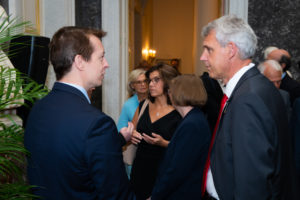
Professor Sir Richard Friend FRS is at the Department of Physics at the University of Cambridge. His research encompasses the physics, materials science and engineering of semiconductor devices made with carbon-based semiconductors, particularly polymers. His research advances have shown that carbon-based semiconductors have significant applications in LEDs, solar cells, lasers, and electronics. These have been developed and exploited through a number of spin-off companies. His current research interests are directed to novel schemes that seek to improve the performance and cost of solar cells.
Professor Friend is a Fellow of the Royal Society and of the Royal Academy of Engineering, and a Foreign Member of the US National Academy of Engineering. He has received many international awards for his research, including Laureate of the Millennium Prize for Technology (2010) the Harvey Prize (2011) of the Israel Institute of Technology and the von Hippel Award of the Materials Research Society (2015). He was knighted for « Services to Physics » in the Queen’s Birthday Honours List, 2003.
Professor Jianqing Fan is Frederick L. Moore Professor, Princeton University. He was the past president of the Institute of Mathematical Statistics and International Chinese Statistical Association. He is co-editing Journal of Business and Economics Statistics and was the co-editor of The Annals of Statistics, Probability Theory and Related Fields, and Journal of Econometrics. His published work on statistics, machine learning, economics, finance, and computational biology has been recognized by numerous awards and honors.
Professor Laura Kiessling earned a BS in Chemistry from the Massachusetts Institute of Technology and a Ph.D. in Organic Chemistry from Yale University. After two years at the California Institute of Technology as an American Cancer Society Postdoctoral Fellow, she joined the faculty of the University of Wisconsin, Madison in 1991. In 2017, she returned to MIT as the Novartis Professor of Chemistry and Member of the Broad Institute. Her interdisciplinary research interests have advanced our understanding of cell surface recognition processes, especially those involving protein-glycan interactions. Laura is a Fellow of the American Association for the Advancement of Science, and a Member of the American Academy of Microbiology, and National Academy of Sciences. She is the current and founding Editor–In-Chief of ACS Chemical Biology. Her honors and awards include a MacArthur Foundation Fellowship, a Guggenheim Fellowship, the ACS Gibbs Medal, the Tetrahedron Prize, and the Centenary Prize from the Royal Society of Chemistry.
Mathieu Luisier is Associate Professor of Computational Nanoelectronics in the Department of Information Technology and Electrical Engineering of ETH Zurich, Switzerland. He earned his diplom in electrical engineering in 2003 and his Ph.D. in the same field in 2007, both from ETH Zurich. In 2008 he joined the Network for Computational Nanotechnology at Purdue University as a Research Assistant Professor before returning to ETH Zurich in 2011. His research focuses on the atomistic modeling and the study of the fundamental properties of nanoscale devices, e.g. ultra-scaled transistors, memories, or photovoltaic cells. Prof. Luisier was the recipient of an ERC Starting Grant in 2013 and of the ACM Gordon Bell Prize in 2019 for outstanding achievement in high-performance computing.
Professor Jens K. Nørskov holds the Villum Kann Rasumussen professorship at the Technical University of Demark and he is chairing the Danish National Research Foundation. His research aims at developing theoretical methods and concepts to understand and predict properties of materials focusing primarily on catalysis and sustainable energy solutions. He has received a number of awards and honors, and he is a member of the Royal Danish Academy of Science and Letters, the Danish Academy of Engineering (ATV), and a foreign member of the US National Academy of Engineering.
Richard J. Samworth is Professor of Statistical Science and Director of the Statistical Laboratory at the University of Cambridge. His research interests are in nonparametric and high-dimensional Statistics. He received the COPSS Presidents’ Award in 2018, and currently serves as co-editor of the Annals of Statistics.
Ewine van Dishoeck is Professor of molecular astrophysics at Leiden University, the Netherlands, following positions at Harvard, Princeton and Caltech. Her many awards include the 2018 Kavli Prize for Astrophysics and the 2018 Watson Medal of the US-NAS. She is a Member or Foreign Associate of several academies, including that of the Netherlands, USA, Germany and Norway. From 2018-2021, van Dishoeck serves as the president of the International Astronomical Union (IAU).
Professor Dr. Martin Wolf received his PhD for studies on surface physics with Gerhard Ertl. After postdoc stays in Austin, Berlin and Yorktown Heights he was appointed in 2000 as full professor in experimental physics at the Freie Universität Berlin and since 2008 he has been director of the Physical Chemistry department at the Fritz Haber Institute of the Max Planck Soceity. His research focuses on the dynamics of elementary excitations at surfaces, interfaces and in solids, ultrafast photoinduced dynamics and transient electronic structure in correlated materials, interfacial electron transfer and vibrational spectroscopy at interfaces.
Members
* * *
